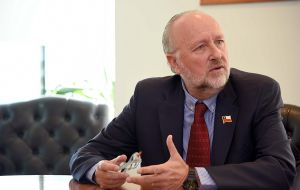MercoPress. South Atlantic News Agency
Chile faced with the challenge of 740 fragile tailing dams from copper mining
 Mines are the pillar of Chile's economy, but their byproducts -often used to create tailings dams, pose a handful of problems for surrounding inhabitants
Mines are the pillar of Chile's economy, but their byproducts -often used to create tailings dams, pose a handful of problems for surrounding inhabitants  “It's not that it couldn't happen here but it would be very difficult,” Chilean Mines Minister Baldo Prokurica said
“It's not that it couldn't happen here but it would be very difficult,” Chilean Mines Minister Baldo Prokurica said From the sky, the glistening emerald ponds of northern Chile are almost beautiful, but closer to the ground they harbor an ugly and dangerous secret: the reservoirs, filled with toxic waste from the country's mining industry, are ticking time bombs.
Mines are the pillar of Chile's economy, but their byproducts - which accumulate in ravines, mountain areas, river beds and reservoirs, and which are often used to create tailings dams, pose a handful of problems for surrounding inhabitants.
Apart from the environmental threat, the recent collapse of two Brazilian dams that killed hundreds of people has triggered alarm in Chile, which produces approximately a third of the world's copper.
“It's not that it couldn't happen here but it would be very difficult,” Chilean Mines Minister Baldo Prokurica said
In 1965, an earthquake measuring 7.4 on the Richter Scale collapsed a Chilean tailings dam leaving more than 300 people dead.
Prokurica said that since then, and precisely because of the country's seismic activity, measures have been taken to prevent another such accident.
Mining sites are built with the same anti-earthquake regulations as buildings, according to Gustavo Lagos, a professor of mining at the country's Catholic University.
Tailings dams are “under tight control. The problem is the little ones or those that have been abandoned”
After more than 100 years of mining activity, Chile has 740 tailings dams, according to the national geology and mining service.
Most are located in the country's northern Coquimbo, Antofagusta and Atacama regions as well as the country's metropolitan center. Of those, 469 are inactive, 170 abandoned.
Critics of these dams say that collapse is not necessarily the biggest problem, and warn of the risk posed by chemical products used to separate the minerals from earth, which are considered particularly dangerous to health and the environment.
“These are sources of pollution for surface water, groundwater and dust that gets transported by the wind,” said Lucio Cuenca, director of the Latin American Observatory for Environmental Conflict (OLCA).
Over the last two decades, the inhabitants of Caimanes, a town around 270km north of Santiago, has been fighting the El Mauro Dam, opened in 2008.
This colossus, which is capable of producing more than two billion tons of waste, could “cut the country in two and bury this town of one thousand people” Cristian Flores, leader of the Caimanes Defense Committee, claims.
Inhabitants can no longer drink the water from the Pupio River, but a financial agreement was signed between the mine owner and local inhabitants.
“The mining industry is a lot safer than it was 10 years ago, but less than it could be in another 10 years,” said Lagos.
“There's always an impact, there's no human activity that doesn't have an impact.”
For every ton of minerals extracted, 30 tons of mining waste are generated. With 1.5 million tons of residue created per day, Chile is the world leader in mining waste.
Increasingly, the waste is transported to landfill sites far away from the mines, using a system of pipes and pressurized water.
But there are no government regulations that enforce the application of safety measures regarding tailings dams and landfill sites, and many are often simply abandoned once they have served their purpose.




Top Comments
Disclaimer & comment rulesCommenting for this story is now closed.
If you have a Facebook account, become a fan and comment on our Facebook Page!